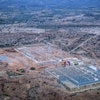
Rocket Lab USA today successfully launched its 33rd Electron rocket and first mission from Virginia. The “Virginia is for Launch Lovers” mission lifted off at 18:00 EST on January 24th from Rocket Lab Launch Complex 2 (LC-2) at Virginia Space’s Mid-Atlantic Regional Spaceport within NASA’s Wallops Flight Facility.
WATCH: Aerospace Company Wants to Try Helicopter Catch Again
The mission deployed three satellites to a 550km orbit for leading radio frequency geospatial analytics provider HawkEye 360. Rocket Lab has now successfully deployed a total of 155 satellites to orbit from the company’s three launch pads across the U.S. and New Zealand.
The successful launch from LC-2 marks the beginning of a new era of responsive launch capability for small satellites from U.S. soil. Built with support from Virginia Space, the Commonwealth of Virginia and NASA Wallops Flight Facility, Rocket Lab Launch Complex 2 is designed to serve the responsive space needs of commercial, civil, defense, and national security customers, supporting up to 12 missions per year. Combined with Rocket Lab’s private Launch Complex 1 site in New Zealand, the company’s launch sites can support more than 130 launch opportunities every year, delivering flexibility and rapid launch capability for customers.
The launch of Electron from the NASA-controlled Wallops Flight Facility also marked the introduction of the agency’s autonomous flight termination capability, known as NAFTU (NASA Autonomous Flight Termination Unit). While Rocket Lab has successfully flown its own autonomous system on Electron missions since 2019, NASA developed NAFTU in conjunction with this launch to provide a common system for flight termination for a wide array of launch vehicles at any launch range. Autonomous flight termination capability now being in operation at Wallops can provide faster and cheaper access to space for small satellites by enabling wider launch windows, smaller launch safety corridors, and reduced reliance on ground-based systems.
The “Virginia is for Launch Lovers” mission was the first of three Electron launches for HawkEye 360 in a contract that will see Rocket Lab deliver 15 satellites to low Earth orbit in 2023 and 2024. These missions will grow HawkEye 360’s constellation of radio frequency monitoring satellites, enabling the company to better deliver precise geolocation of radio frequency emissions anywhere in the world. Supporting Rocket Lab’s vertical integration strategy, Rocket Lab will also supply HawkEye 360 with separation systems produced by Planetary Systems Corporation, a Maryland-based space hardware company acquired by Rocket Lab in December 2021.
Virginia is the first U.S. launch location of the Electron launch vehicle, but it will also be home to the company’s new larger launch vehicle Neutron, which will be built, tested, launched, and landed within the Wallops Flight Facility in the future. Construction is underway of the Neutron Production Complex as development of the new rocket progresses, thanks to the continuous support from the Commonwealth and Virginia Space.






















